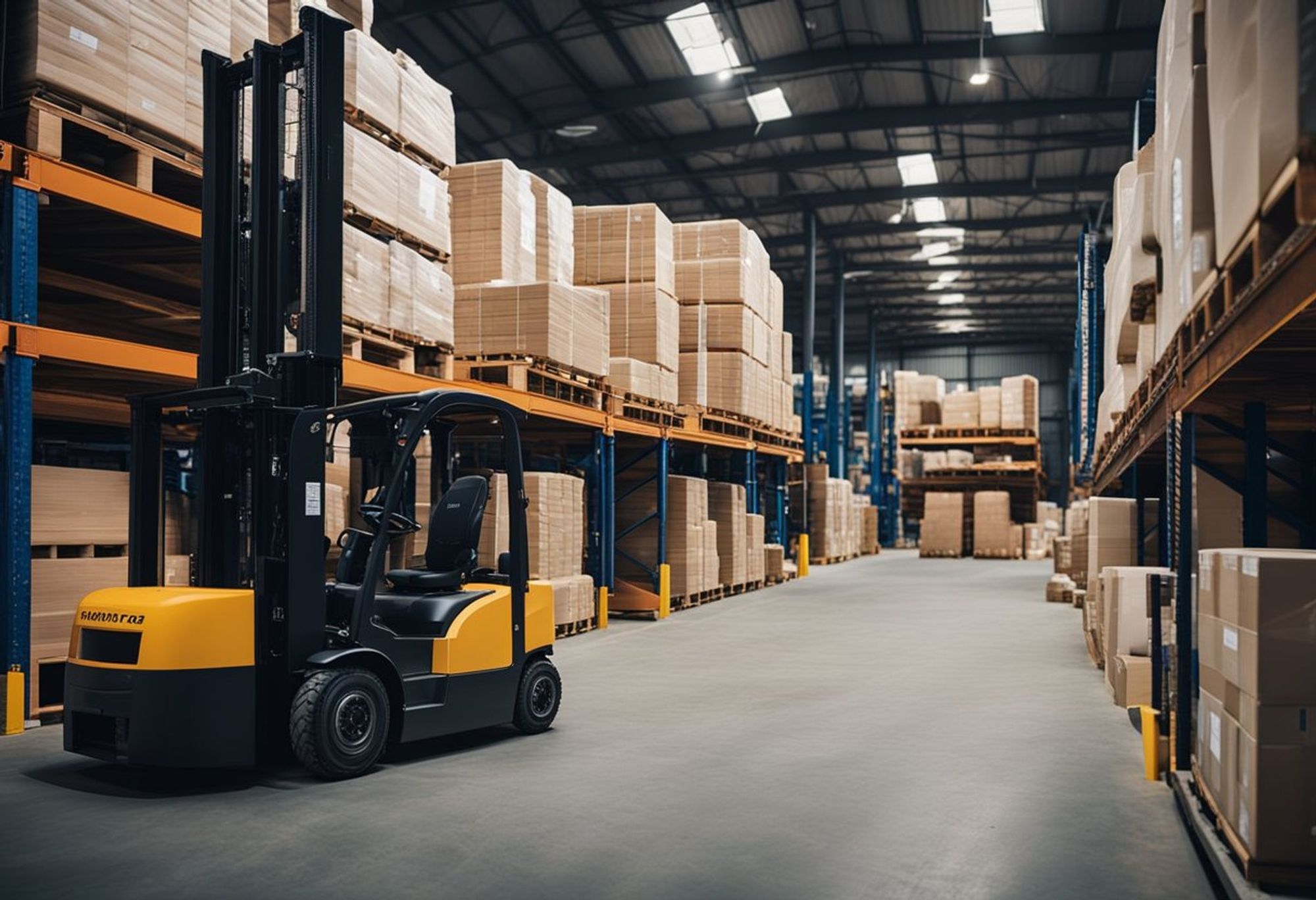
2024-05-28,
11:33:38
Strategic Sourcing: Navigating the Landscape for Raw Materials
 By Buyamia
By BuyamiaSource Raw Materials: A Guide to Finding Quality Suppliers
Source raw materials is a critical process for any business that produces goods. Raw materials are the basic building blocks of any product, and without them, the production process cannot begin. Raw materials can come from a variety of sources, including natural resources, suppliers, and even recycled materials. However, sourcing raw materials is not always straightforward, and it can be a complex process that requires careful planning and execution.
One of the first steps in sourcing raw materials is identifying the raw material needs of the business. This involves determining the types and quantities of raw materials required for production. Once the raw material needs have been identified, the business can begin to look for suppliers. Supplier selection and evaluation are crucial steps in the sourcing process, as choosing the wrong supplier can result in poor quality raw materials, delayed delivery times, or even supply chain disruptions.
Key Takeaways
-
Identifying the raw material needs of the business is the first step in sourcing raw materials.
-
Supplier selection and evaluation are crucial steps in the sourcing process.
-
Quality assurance, logistics, and sustainability are important considerations when sourcing raw materials.
Identification of Raw Material Needs
Before sourcing raw materials, it is important to identify the specific needs of the product or process. This includes determining the quantity, quality, and specifications of the raw materials required.
One way to identify raw material needs is to review the product or process specifications. This may include the chemical composition, physical properties, and performance requirements of the raw materials. It is also important to consider any regulatory requirements or industry standards that may impact the selection of raw materials.
Another way to identify raw material needs is to conduct a risk assessment. This involves evaluating the potential impact of raw material quality, availability, and cost on the product or process. A risk assessment can help identify critical raw materials and potential supply chain vulnerabilities.
Once the raw material needs have been identified, it is important to develop a sourcing strategy. This may include identifying potential suppliers, evaluating supplier capabilities and capacity, and negotiating contracts and pricing. It is also important to establish quality control measures and testing protocols to ensure that the raw materials meet the required specifications.
Overall, identifying raw material needs is an important step in the sourcing process. By understanding the specific requirements of the product or process, companies can develop an effective sourcing strategy that ensures reliable and consistent supply of high-quality raw materials
Supplier Selection and Evaluation
Selecting the right supplier is crucial for any business that relies on raw materials. A good supplier can provide high-quality materials at a reasonable price, while a bad supplier can cause delays, quality issues, and even legal problems. Therefore, it is essential to have a robust supplier selection and evaluation process in place.
Criteria for Choosing Suppliers
When selecting a supplier, there are several criteria that businesses should consider. These criteria can include:
-
Quality: The supplier should be able to provide materials that meet the required quality standards. This can be assessed by reviewing the supplier’s quality control processes, certifications, and test results.
-
Price: The supplier’s prices should be competitive and reasonable. However, it is important to note that the cheapest option may not always be the best option in the long run.
-
Reliability: The supplier should be able to deliver materials on time and in the required quantities. This can be assessed by reviewing the supplier’s delivery history and lead times.
-
Customer service: The supplier should be responsive to inquiries and issues, and should be willing to work with the business to resolve any problems that arise.
-
Sustainability: The supplier’s environmental and social impact should be considered, especially if the business has sustainability goals.
By considering these criteria, businesses can identify potential suppliers and evaluate them based on their ability to meet the business’s needs.

Supplier Audits and Compliance
Once a supplier has been selected, it is important to evaluate their compliance with relevant laws, regulations, and standards. This can include:
-
Environmental regulations: The supplier should comply with local and national environmental laws and regulations, such as those related to waste disposal and emissions.
-
Labor standards: The supplier should comply with labor laws and regulations, such as those related to minimum wage, working hours, and child labor.
-
Product safety: The supplier should comply with relevant product safety standards, such as those related to materials testing and labeling.
To evaluate compliance, businesses can conduct supplier audits, either internally or through a third-party auditor. These audits can assess the supplier’s compliance with relevant laws and regulations, as well as their adherence to the business’s own standards and requirements.
By selecting and evaluating suppliers based on these criteria, businesses can ensure that they are working with reliable, high-quality suppliers who can help them achieve their goals.
Sourcing Strategies
When it comes to sourcing raw materials, there are several strategies that companies can pursue. Two of the most common strategies are local vs. global sourcing and long-term contracts vs. spot buying.
Local vs. Global Sourcing
One of the first decisions that companies must make when sourcing raw materials is whether to source locally or globally. Local sourcing involves purchasing materials from suppliers within the same country or region, while global sourcing involves purchasing materials from suppliers in other countries.
Local sourcing has several advantages. For one, it can help companies reduce their transportation costs and lead times. Additionally, local suppliers may be more familiar with local regulations and customs, which can help companies navigate complex legal and cultural issues.
On the other hand, global sourcing can offer several advantages as well. For example, companies may be able to find lower prices or higher-quality materials by sourcing from suppliers in other countries. Additionally, global sourcing can help companies diversify their supply chains, reducing their risk of disruptions due to natural disasters, political instability, or other factors.
Long-Term Contracts vs. Spot Buying
Another important decision that companies must make when sourcing raw materials is whether to use long-term contracts or spot buying. Long-term contracts involve purchasing materials from a supplier over an extended period, while spot buying involves purchasing materials on an as-needed basis.
Long-term contracts can offer several advantages. For one, they can help companies secure a stable supply of materials, which can be especially important for companies that rely on a particular material for their products. Additionally, long-term contracts can help companies negotiate better prices and other terms with their suppliers.
However, spot buying can also be a useful strategy in some cases. For example, if a company only needs a small amount of a particular material, it may be more cost-effective to purchase it on a spot basis rather than entering into a long-term contract. Additionally, spot buying can help companies take advantage of sudden price drops or other market fluctuations.
Overall, companies must carefully consider their sourcing strategies when it comes to raw materials. By weighing the pros and cons of different approaches and staying up-to-date on market trends and supplier capabilities, companies can make informed decisions that help them secure the materials they need to succeed.
Procurement Process
Raw material procurement is a critical process that ensures the uninterrupted supply of quality materials at the right price. The procurement process involves several steps that require careful planning and execution to minimize risks and maximize efficiency.
Purchase Requisitions
The procurement process begins with the identification of the need for raw materials. This need is communicated to the procurement department through a purchase requisition. A purchase requisition is a document that specifies the quantity, quality, and delivery date of the required raw materials. The procurement department then evaluates the purchase requisition and initiates the procurement process.

Negotiation and Contracting
Once the procurement department receives the purchase requisition, they begin the process of identifying potential suppliers. The procurement team evaluates potential suppliers based on several factors such as quality, price, delivery time, and reliability. After identifying potential suppliers, the procurement team negotiates the terms and conditions of the contract. The contract specifies the price, quantity, delivery time, and quality of the raw materials. The terms of the contract also include clauses that protect the interests of both parties.
Order Management
After the contract is finalized, the procurement team places an order with the supplier. The order management process involves tracking the order from the time it is placed until it is delivered. The procurement team ensures that the supplier delivers the raw materials as per the terms of the contract. They also ensure that the quality of the raw materials meets the specified standards. In case of any issues, the procurement team takes appropriate action to resolve them.
In conclusion, the procurement process is a critical aspect of raw material sourcing. It involves several steps that require careful planning and execution. By following a well-defined procurement process, organizations can ensure the uninterrupted supply of quality raw materials at the right price.
Quality Assurance
When it comes to raw materials, quality assurance is critical to ensure the reliability and durability of the finished product. Quality assurance is the process of verifying that the raw materials used in production meet the required specifications and standards. This process is important because it helps to minimize the risk of defects, recalls, and other issues that can negatively impact the end product.
Material Specifications
The first step in quality assurance is to establish material specifications. Material specifications define the requirements that the raw materials must meet to be considered acceptable for use in production. These specifications typically include information such as the chemical composition, physical properties, and any other relevant characteristics of the raw material.
To ensure that the raw materials meet the required specifications, it is important to work closely with suppliers. Suppliers should be able to provide detailed information about the raw materials they are providing, including test results, certificates of analysis, and other documentation that verifies the quality of the raw materials.
Testing and Validation
Once the material specifications have been established, it is important to test the raw materials to ensure that they meet the required standards. This testing can be done in-house or by a third-party laboratory. Testing should include a range of different quality control measures, such as chemical analysis, physical testing, and microbiological testing.
Validation is another important aspect of quality assurance. Validation is the process of verifying that the testing methods used to ensure the quality of the raw materials are accurate and reliable. This process involves testing a range of different samples to ensure that the results are consistent and reproducible.
Overall, quality assurance is critical to ensuring the reliability and durability of the finished product. By establishing material specifications and performing rigorous testing and validation, manufacturers can minimize the risk of defects, recalls, and other issues that can negatively impact the end product.
Logistics and Supply Chain Management
Logistics and supply chain management play a crucial role in the sourcing of raw materials. Effective management of logistics and supply chain can help companies optimize their inventory maintenance and management, ensuring that manufacturers have all the raw materials they need to make goods.
Inventory Management
Inventory management is an essential aspect of logistics and supply chain management. It involves tracking and managing the flow of raw materials, work-in-progress, and finished goods. Effective inventory management ensures that the right amount of raw materials is available at the right time, minimizing waste and reducing the cost of carrying inventory.
Companies can use different inventory management techniques to optimize their inventory levels. For example, just-in-time (JIT) inventory management is a popular technique that involves ordering raw materials only when they are needed in the production process. This technique helps companies minimize inventory costs while ensuring that they have the necessary raw materials to meet customer demand.
Transportation and Warehousing
Transportation and warehousing are other critical aspects of logistics and supply chain management. Raw materials must be transported from suppliers to manufacturers, and finished goods must be transported to customers. Effective transportation management involves selecting the right mode of transportation, optimizing the transportation route, and managing transportation costs.
Warehousing is also an essential aspect of logistics and supply chain management. Raw materials and finished goods must be stored in a warehouse before they can be transported to their final destination. Effective warehousing involves managing inventory levels, optimizing warehouse space, and ensuring that the warehouse is organized for efficient material handling.
In conclusion, logistics and supply chain management are critical to the sourcing of raw materials. Effective management of logistics and supply chain can help companies optimize their inventory maintenance and management, reduce costs, and ensure that manufacturers have all the raw materials they need to make goods.
Sustainability and Ethical Sourcing
Sustainability and ethical sourcing are two critical factors to consider when sourcing raw materials. Companies that prioritize these factors in their sourcing decisions can reduce their environmental impact and ensure social responsibility.
Environmental Impact
Sustainable sourcing involves selecting materials, products, and services from suppliers in a way that minimizes negative environmental impacts while maximizing positive outcomes. By sourcing raw materials from sustainable sources, companies can reduce their carbon footprint, conserve natural resources, and protect biodiversity.
One way to achieve sustainable sourcing is by selecting suppliers that have implemented environmentally friendly practices in their operations. For example, suppliers that use renewable energy, minimize waste, and reduce emissions can help companies reduce their environmental impact.
Another way to achieve sustainable sourcing is by selecting materials that have been certified by reputable organizations. For example, companies can look for materials that have been certified by the Forest Stewardship Council (FSC) or the Rainforest Alliance, which ensure that the materials have been sourced responsibly.

Social Responsibility
Ethical sourcing involves selecting suppliers that manufacture or procure products responsibly and sustainably. It is a component of sustainable sourcing but not the same thing. Companies that prioritize ethical sourcing can ensure that their products are produced under fair labor conditions and that their suppliers treat their workers with respect and dignity.
One way to achieve ethical sourcing is by selecting suppliers that have implemented fair labor practices in their operations. For example, suppliers that pay fair wages, provide safe working conditions, and prohibit child labor can help companies ensure social responsibility.
Another way to achieve ethical sourcing is by selecting suppliers that have been certified by reputable organizations. For example, companies can look for suppliers that have been certified by the Fair Trade USA or the Fair Labor Association, which ensure that the suppliers meet certain ethical standards.
Overall, companies that prioritize sustainability and ethical sourcing can reduce their environmental impact and ensure social responsibility. By selecting suppliers that have implemented environmentally friendly and fair labor practices, companies can contribute to a more sustainable and equitable world.
Risk Management
Raw material sourcing is a critical aspect of supply chain management. Organizations must be prepared to manage risks associated with the sourcing of raw materials. There are two main risks associated with raw material sourcing that organizations need to manage: market volatility and supply disruption.
Market Volatility
Market volatility can lead to price fluctuations for raw materials. This can have a significant impact on the cost of production for organizations. To manage this risk, organizations should consider implementing a hedging strategy. Hedging involves taking positions in the futures market to offset the risk of price fluctuations. This can help organizations to lock in prices for raw materials and reduce the impact of market volatility on their operations.
Supply Disruption
Supply disruption is another key risk associated with raw material sourcing. Disruptions can occur due to a variety of factors, such as natural disasters, geopolitical events, and supplier bankruptcy. To manage this risk, organizations should consider implementing a supplier risk management program. This program should include regular supplier assessments, supplier diversification, and contingency planning. By implementing these measures, organizations can reduce the impact of supply disruptions on their operations.
In addition to these risks, organizations must also be aware of the risks associated with quality and safety of raw materials. Organizations should implement a robust quality control program to ensure that raw materials meet their specifications and are safe for use in their operations. This program should include regular testing and inspection of raw materials, as well as supplier audits to ensure that suppliers are meeting quality and safety standards.
Overall, effective risk management is critical for organizations that source raw materials. By implementing a comprehensive risk management program, organizations can reduce the impact of risks on their operations and ensure that they have a reliable supply of high-quality raw materials.
Technological Integration
The integration of technology in the sourcing of raw materials has revolutionized the procurement process. Automation and data analytics have made it possible to streamline the sourcing process, reduce costs, and increase efficiency. This section will discuss two key areas of technological integration in sourcing: Automation and Data Analytics.
Automation in Sourcing
Automation has transformed the way raw materials are sourced. Automated systems can identify and track suppliers, manage inventory, and monitor prices. This has significantly reduced the time and effort required to identify and procure raw materials. Automated systems can also help to reduce errors and ensure compliance with regulations.
One key advantage of automation is that it allows for real-time monitoring of supply chain activities. This can help to identify potential disruptions and enable companies to take proactive measures to avoid them. Automation can also help to reduce costs by optimizing the procurement process and reducing the need for manual intervention.
Data Analytics in Procurement
Data analytics has become an essential tool in the sourcing of raw materials. Data analytics can help to identify trends, patterns, and potential risks in the procurement process. This can help companies to optimize their procurement strategies and reduce costs.
Data analytics can also help to improve supplier relationships. By analyzing supplier performance data, companies can identify areas for improvement and work with suppliers to address them. This can help to build stronger relationships and ensure a reliable supply of raw materials.
In addition, data analytics can help to ensure compliance with regulations. By analyzing data, companies can identify potential compliance issues and take proactive measures to address them. This can help to avoid costly fines and reputational damage.
In conclusion, the integration of technology in the sourcing of raw materials has transformed the procurement process. Automation and data analytics have made it possible to streamline the sourcing process, reduce costs, and increase efficiency. Companies that embrace these technologies are well-positioned to succeed in the competitive sourcing landscape.
Frequently Asked Questions
What are the key factors to consider when developing a raw material sourcing strategy?
Developing a raw material sourcing strategy requires a thorough understanding of the business’s needs, goals, and available resources. Companies must consider factors such as the cost, quality, and availability of raw materials, as well as the environmental impact of their sourcing decisions. Additionally, it’s important to consider factors such as supplier relationships, transportation logistics, and potential risks in the supply chain.
How can businesses effectively identify new sources of raw materials?
To identify new sources of raw materials, businesses can conduct market research, attend industry conferences, and network with suppliers and other industry professionals. Additionally, businesses can leverage technology to monitor trends in the market and identify potential opportunities for new sourcing partnerships.
What are some common challenges faced when sourcing raw materials in the supply chain?
Common challenges when sourcing raw materials include price volatility, supply chain disruptions, quality control issues, and environmental concerns. Additionally, geopolitical factors such as trade policies and regulations can impact the availability and cost of raw materials.
How do companies determine the quality and suitability of raw materials for their products?
Companies typically use a combination of testing, inspections, and certifications to determine the quality and suitability of raw materials for their products. This may include conducting laboratory tests, inspecting supplier facilities, and verifying compliance with industry standards and regulations.
What role does the raw material industry play in global supply chains?
The raw material industry plays a critical role in global supply chains by providing the foundational materials necessary for the production of finished goods. Raw materials are sourced from a variety of locations around the world and transported through complex supply chains to reach manufacturers and retailers.
Can you provide examples of how raw materials are transformed into finished products?
Raw materials are transformed into finished products through a variety of manufacturing processes. For example, cotton is transformed into clothing through spinning, weaving, and dyeing processes. Iron ore is transformed into steel through smelting and refining processes. The specific manufacturing process used depends on the type of raw material and the finished product being produced.
Unlock Your Supply Chain Potential: Explore Buyamia’s Guide to Sourcing Raw Materials!
Elevate your sourcing strategies with expert insights and actionable tips tailored to help you secure high-quality raw materials. Navigate challenges, optimize processes, and streamline your supply chain for maximum efficiency. Click here to access Buyamia.com premium guide and revolutionize your approach to sourcing raw materials today!
Looking for an out of the box ecommerce marketplace solution? We’ve got you covered. We offer Buyamia’s technology as a solution you can use for your own marketplace.
Learn More
